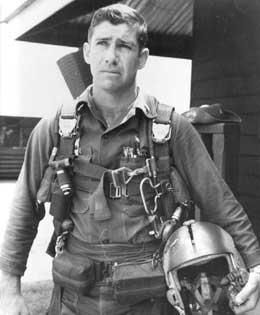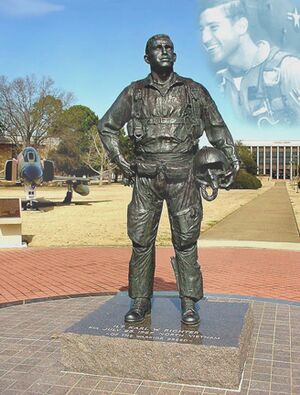Karl W. Richter facts for kids
Quick facts for kids
Karl Wendell Richter
|
|
|---|---|

Lt Karl Richter
|
|
| Born | October 4, 1942 Holly, Michigan, U.S. |
| Died | July 28, 1967 (aged 24) Vietnam |
| Place of burial |
United States Air Force Academy Cemetery
|
| Allegiance | United States of America |
| Service/ |
|
| Years of service | 1964–1967 |
| Rank | |
| Unit | 421st Tactical Fighter Squadron 388th Tactical Fighter Wing |
| Battles/wars | Vietnam War † |
| Awards | Air Force Cross Silver Star Distinguished Flying Cross (4) Bronze Star Purple Heart Air Medal (22) Jabara Award |
Karl Wendell Richter (born October 4, 1942 – died July 28, 1967) was a brave pilot in the United States Air Force. He was an amazing fighter pilot during the Vietnam War. At just 23 years old, he became the youngest pilot in that war to shoot down an enemy MiG plane.
Contents
Becoming a Pilot
Karl W. Richter was born in Holly, Michigan, on October 4, 1942. He was the youngest of three children. From a young age, Karl loved everything about flying. His older sister, Betty, helped him learn more about planes.
By the time he was 18, Karl was already a very skilled pilot. With his sister's encouragement, he applied to the United States Air Force Academy. He was accepted and graduated on June 3, 1964. He officially became a second lieutenant in the Air Force.
After the Academy, Karl went through a lot of flight training. He spent 53 weeks learning to fly at Craig Air Force Base in Alabama. Then, he trained for 26 weeks at Nellis Air Force Base in Nevada. This training prepared him to fly the powerful F-105 Thunderchief jet.
On April 6, 1966, Karl flew an F-105 jet directly to Korat Royal Thai Air Force Base in Thailand. He was assigned to the 421st Tactical Fighter Squadron. Just four days later, he was already flying missions over North Vietnam.
Flying in Vietnam
Karl Richter quickly became a top fighter pilot. He loved to fly and took every chance he could get. Even though he had only been in the Air Force for two years, he became a leader in his squadron.
Once, during his time off, he could have gone to places like Bangkok or Hong Kong. Instead, he chose to fly more combat missions. He went to another base and flew a different type of plane, an O-1E Bird Dog, just to gain more experience.
First MiG Shot Down
On September 21, 1966, Karl was flying north of Haiphong. His mission was to find enemy missile sites. Suddenly, he saw two enemy MiG-17 jets flying nearby.
Karl quickly decided what to do. He moved his F-105 closer to the enemy planes. He fired his powerful 20mm cannon at one of the MiGs. His shots hit the enemy plane. Just as his gun ran out of bullets, the MiG's wing broke off. Karl saw the enemy pilot safely eject from the plane.
Karl later said, "It's strange, but, in a way, I was happy he got a good chute." This showed his respect for other pilots, even if they were on the enemy side.
At only 23 years old, Karl Richter became the youngest American pilot to shoot down a MiG over Vietnam. He received congratulations from high-ranking generals. He also received the Vietnamese Distinguished Service Medal from the Premier of Vietnam.
More Missions and Awards
Karl had flown nearly 100 missions. He then asked for permission to fly another 100 missions. He believed his experience could help the war effort.
On April 20, 1967, Karl led a group of F-105s. They were on a mission to destroy or stop enemy anti-aircraft guns and missile crews. This helped other planes complete their mission to destroy an important railroad target. Even with heavy enemy fire and bad weather, Karl showed great skill.
For his bravery and skill that day, he received the Air Force Cross. This is a very high award for heroism. He had already received the Silver Star for his courage.
Karl's Last Mission
On July 28, 1967, Karl was flying with a new pilot. He spotted a bridge and told the new pilot to stay above and watch. Karl then flew his F-105 towards the target.
Suddenly, enemy anti-aircraft guns fired at his plane. His F-105 was hit, and he had to eject. His parachute disappeared into the clouds. Other American planes quickly came to help. They used special equipment to find Karl's exact location on the ground.
Rescue helicopters and more fighter jets arrived. They worked together to pick him up. Karl's parachute had landed on a rocky hill. He was badly hurt and sadly passed away while being taken to the hospital.
At the time of his death, Karl Richter had flown 198 missions over North Vietnam. This was more than any other airman. He is buried at the United States Air Force Academy Cemetery in Colorado Springs, Colorado.
Remembering Karl Richter
There is a statue of Karl Richter at Maxwell Air Force Base in Alabama. It has a special message: "Whom shall I send, and who will go for us? Here am I. Send me." This statue was made by Glenna Goodacre and was dedicated on June 13, 1992.
Another statue of Karl Richter stands at the Mall of Heroes at the United States Air Force Academy in Colorado.
His old high school in his hometown of Holly, Michigan is now named the "Karl Richter Community Center" in his honor.
Awards and Honors
Karl Richter received many awards for his bravery and service:
- Air Force Cross
- Silver Star
- Distinguished Flying Cross (with a "V" device for valor and three bronze oak leaf clusters)
- Bronze Star (with a "V" device for valor)
- Purple Heart
- Air Medal (with four silver oak leaf clusters)
- Air Force Commendation Medal
- Air Force Outstanding Unit Award
- Air Force Recognition Ribbon
- National Defense Service Medal
- Vietnam Service Medal (with a bronze campaign star)
- Air Force Longevity Service Award
- Small Arms Expert Marksmanship Ribbon
- Vietnam Air Force Distinguished Service Order (2nd Class)
- Republic of Vietnam Gallantry Cross (with palm and frame)
- Vietnam Campaign Medal (with "60-" clasp)
In 1969, he was given the Air Force Academy's Jabara Award for airmanship after his death. In 2005, he was named the "class exemplar" for the Academy's Class of 2008. This means he was chosen as a role model for that graduating class.


